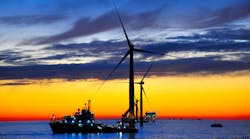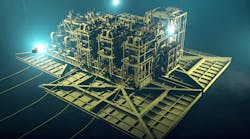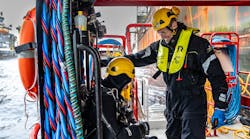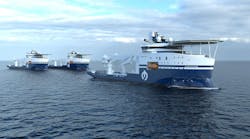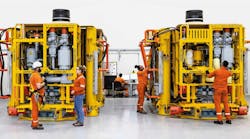Editor's note: This story first appeared in the January-February 2023 issue of Offshore magazine. Click here to view the full issue.
By Jeremy Beckman, Editor, Europe
ABB is supplying most of the electrical topside and subsea equipment, and managing engineering of the power transmission system, to drive Chevron’s Jansz-Io deepwater subsea compression development, 200 km offshore north-west Australia.
For ABB, this is also the company’s first project combining power from shore with Variable Speed Drive (VSD) long step-out subsea power. According to Johan de Villiers, SVP Global Industry Manager for Offshore Oil, Gas and Offshore Wind, the arrangement will bring major efficiency and performance benefits compared with a more traditional platform-based power/compression arrangement. Chevron and its partners aim to recover a further 306 MMboe from the Gorgon area with this development.
“The normal power set-up offshore is a single-cycle gas turbine on the platform,” de Villiers explains. When you connect the platform instead to a shore-based power supply, you have better options, namely the possibility to connect it either to renewable energy or to power generated by combined-cycle turbines onshore, as is the case with Jansz-Io. This brings efficiency gains, with around 80% of carbon emissions from gas production in this project resulting from power generation. Gas turbines on a platform also take up a lot of space, and are a key driver of maintenance. Removing them saves space on the platform, which can in turn become smaller, and that too reduces the emissions associated with steel construction.”
For Jansz-Io, there will be a power transformer on the seabed at 1,400 m water depth, connected via a cable to VSDs on the 27,000-metric ton, normally unattended field control station, under construction by DSME in Geoje, South Korea. The control station will receive power generated on Barrow Island via a new 135-km, 100MVA submarine cable, manufactured and installed by Nexans. The transformer will feed electricity to around 6,500 mt of subsea compression equipment, which is due to start operating in 2025. The configuration includes three compressor modules, two subsea pump modules, all-electric control systems and actuators, and an HV electrical power distribution system.
According to de Villiers, depending on the water depth or the gas that is being compressed, there can be further efficiency gains on top of those provided by the power from shore connection. At the same time, the subsea step-down transformer has to be placed on the sea floor in a protective housing, and must be designed to withstand pressures at significant water depths. However, ABB has already proven these capabilities under a joint industry project, supported by Chevron, Equinor and TotalEnergies and completed in 2019, which involved long-term trials of a subsea power distribution and conversion system that included VSDs, transformers, medium-voltage switchgear, and low-voltage power distribution electronics and controls. The program confirmed that the system can maintain a reliable power supply of up to 100 MW in water depths of up to 3,000 m (9,842 ft), and over a distance of up to 600 km (373 mi) through a single submarine power cable.
ABB also worked with Aker Solutions on the world’s first subsea compression project at the Åsgard field in the Norwegian Sea, which has operated successfully since start-up in 2015. “Our equipment controls the electrical system for the subsea compressors from the platform, where the VSDs are located,” said Asmund Maland, Group SVP, Segment Subsea and Offshore Power at ABB. “The voltage there is taken up to 30-40 kV, which subsea transformers then step down to the voltage required by the compressor motors. Equinor has confirmed the reliability of ABB’s equipment as being close to 100% over the past seven years, which is even better than we had expected.” No major modifications will be needed to the existing power equipment to accommodate the additional subsea compression facilities under development for Åsgard, Maland added.
Maland further noted that “when the decision was taken to expand subsea compression at Åsgard, Chevron and its partners were also choosing their preferred power solution for subsea compression at Jansz-Io. Chevron had evaluated various concepts based on lessons learnt from Åsgard and discussions with Aker Solutions: ABB came onboard through the company’s existing subsea alliance with Aker Solutions, and went to perform pre-FEED feasibility studies for Jansz-Io, followed by the one-year FEED phase to prepare for the final investment decision.”
Jansz-Io is actually two projects, with ABB managing the power developments on Barrow Island as well as on the floating platform. There is a large combined-cycle gas turbine plant on the island that is used to power production of LNG from the Gorgon field’s gas. Maland said that “for this project, we are tapping up to 100 MVA: sending that voltage 140 km offshore through a subsea cable is not cutting edge: however, the equipment on the island that must be adapted and controlled to feed a stable voltage to the offshore control station. If you lose loads on the platform for one compressor string, the voltage then rises and you would then need to compensate for that on the island. Designing that type of system is a specialty of ABB.”
The current Jansz-Io represents a first phase of subsea compression. There is space on the control station platform to implement a second phase, providing more power if required.
“Subsea compression is typically more efficient in deeper water, as here you need more energy to lift the gas from the wells,” Maland added. “For Jansz-Io, the efficiency is 40-60%. With the subsea power link there is an efficiency at the shore of 70% for the combined cycle plant. Using cooling water, you then lose 10% of this in the cable, but that still leaves 60% efficiency. If you compare that with the conventional approach of gas turbines on a platform, with only 30-35% efficiency, that’s a big reduction in CO2 emissions.”
ABB is assembling its equipment for the project in factories in Switzerland, the switchgear at other factories in Europe, and the e-housings in Australia. Nexans is responsible for manufacturing and installing the 140-km subsea cable, having previously completed a qualification process for the cable design.


